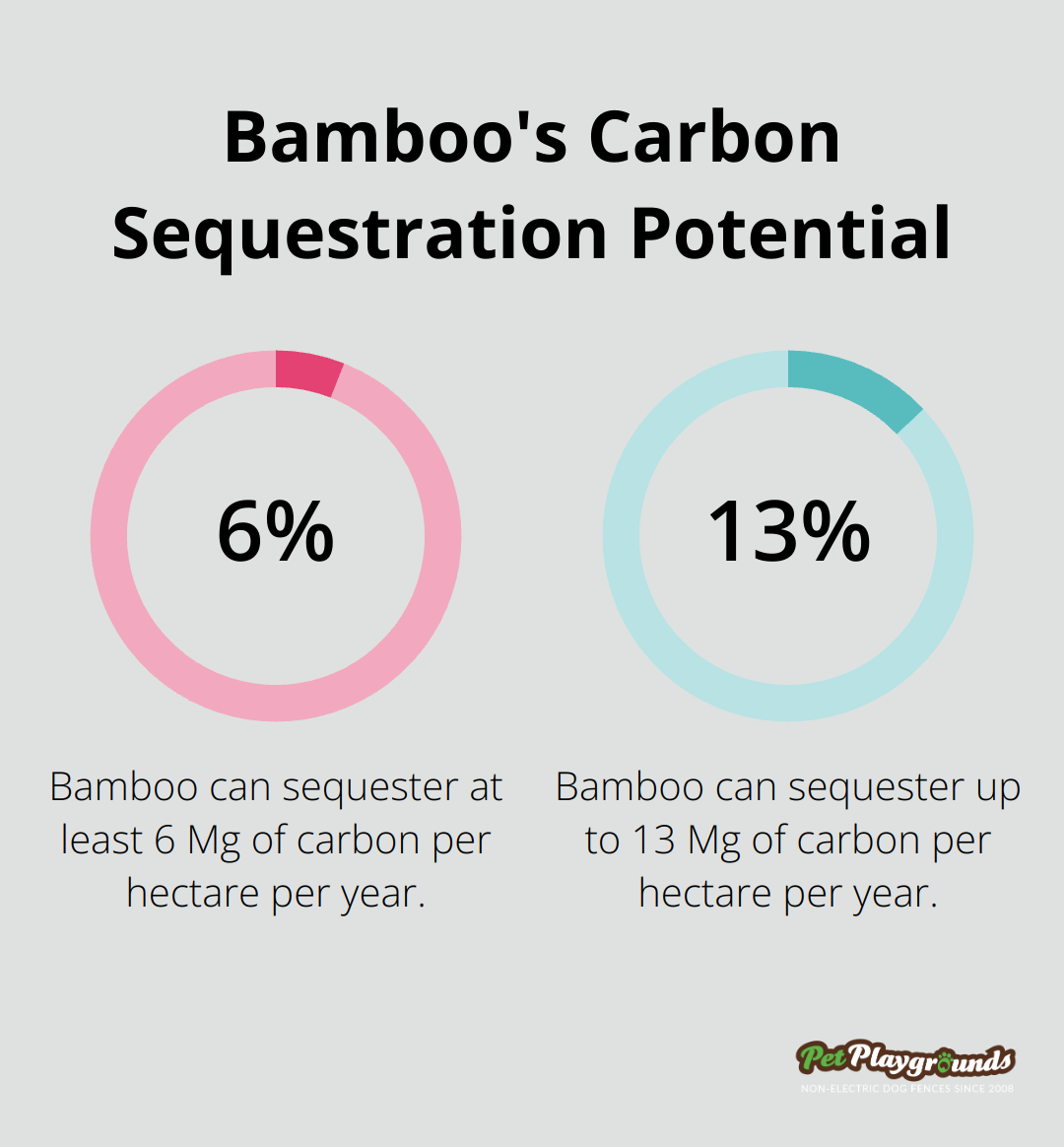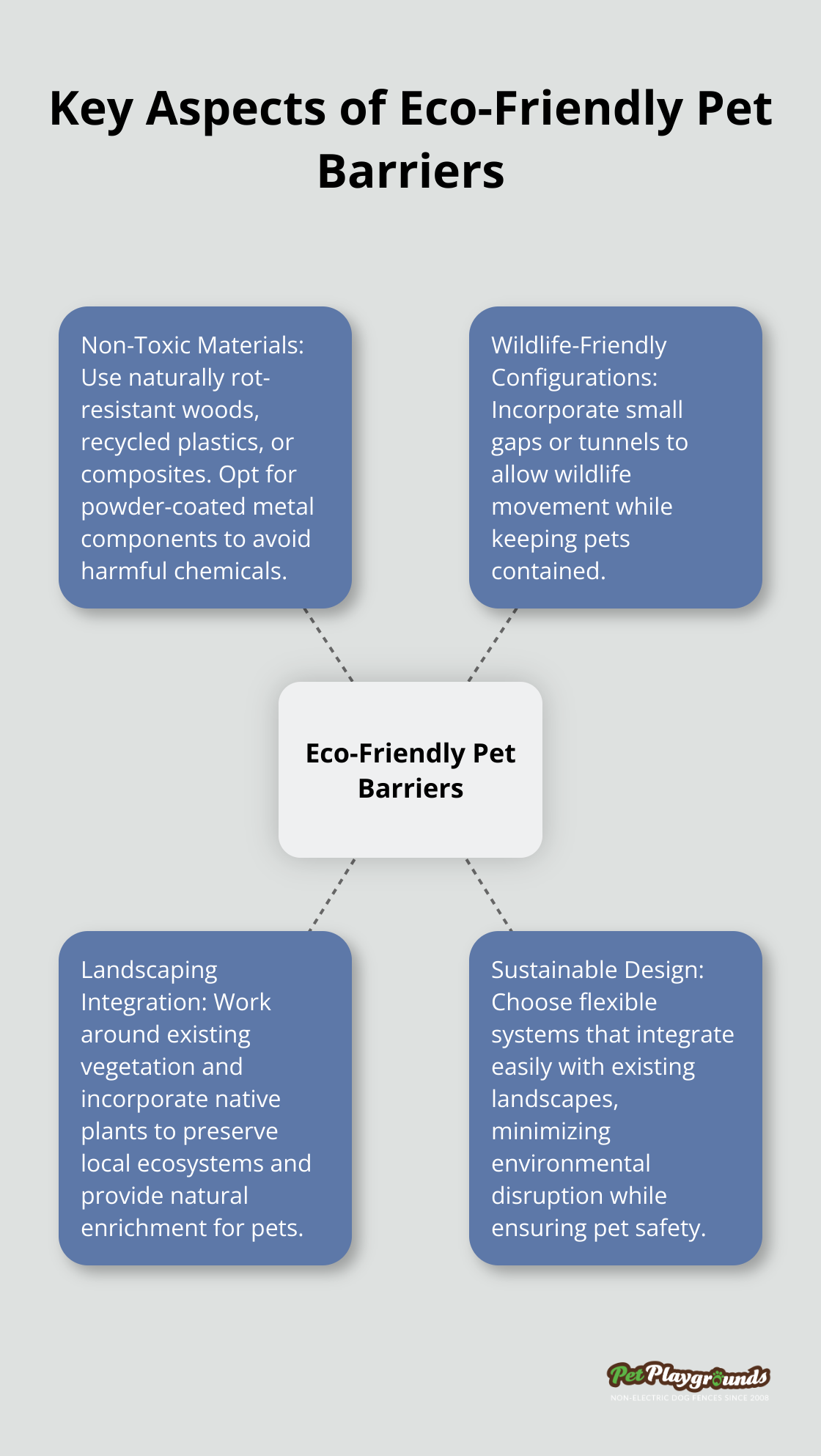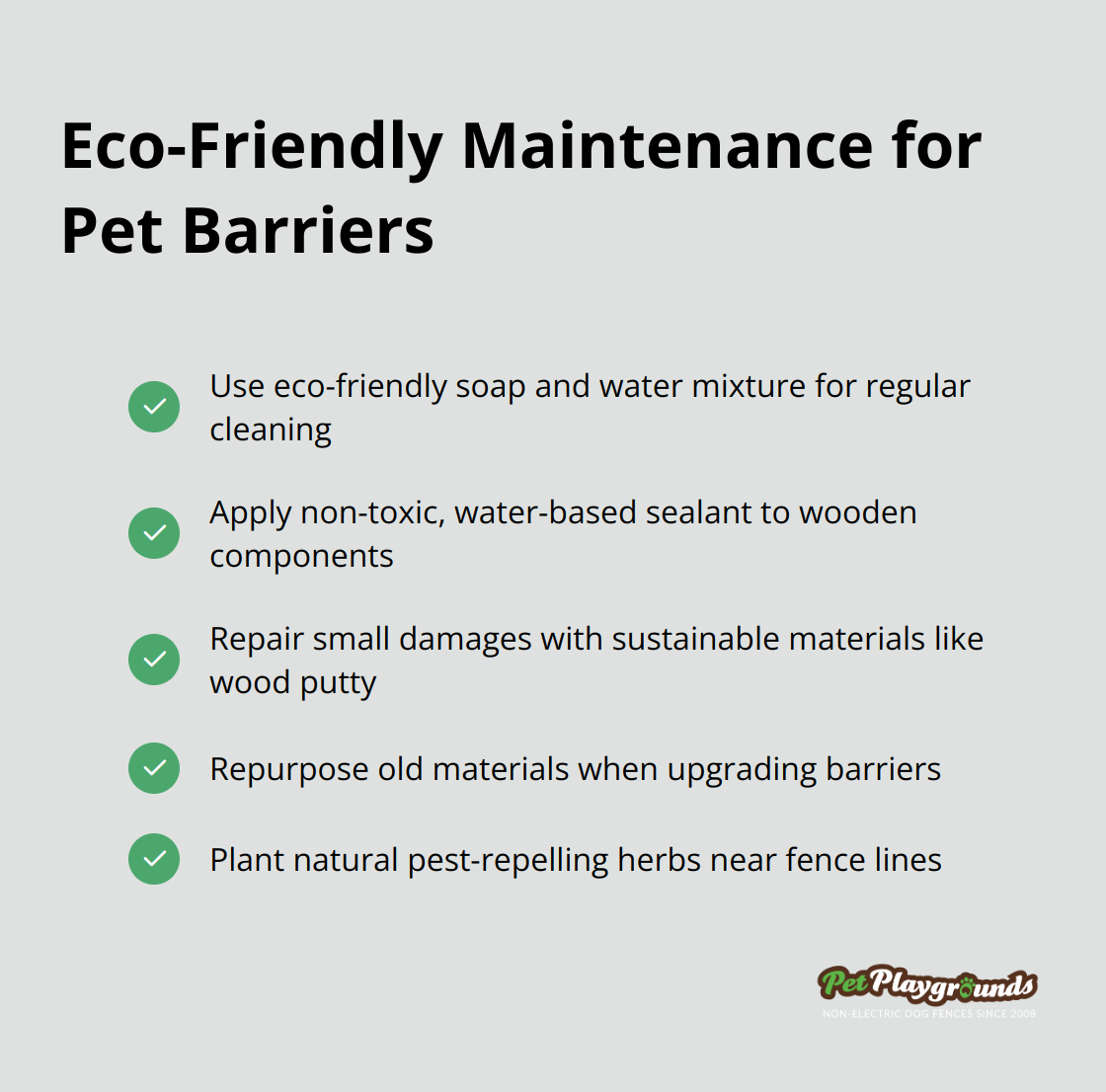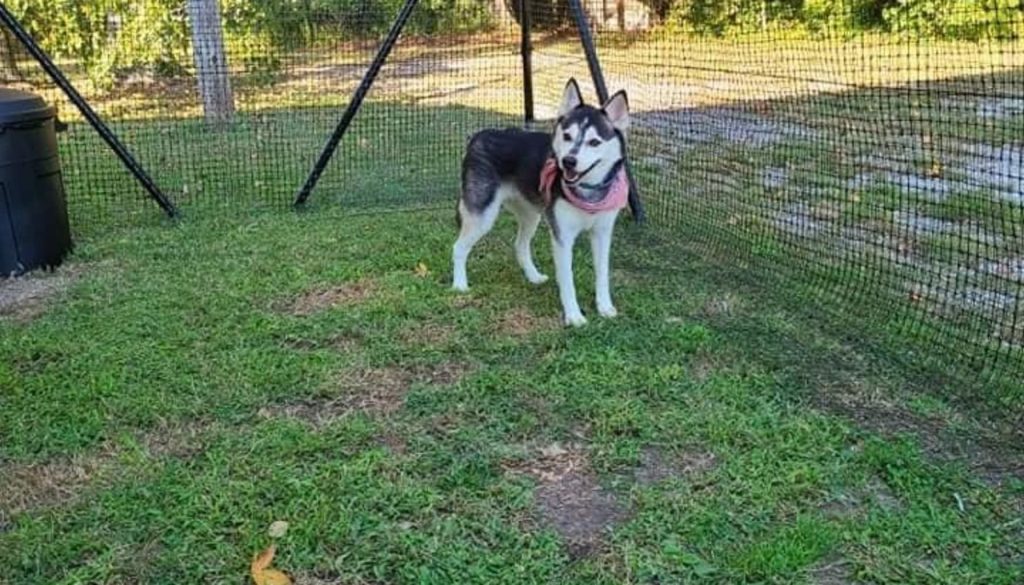At Petplaygrounds Non electric dog fence, we understand the importance of keeping your pets safe while also being mindful of the environment. Creating a sustainable pet barrier for your yard doesn’t have to be a challenge.
In this post, we’ll explore eco-friendly fencing options and design strategies that protect your furry friends and the planet. We’ll also share tips on maintaining and extending the life of your sustainable pet barrier, helping you make a positive impact for years to come.
Sustainable Materials for Pet Barriers
At Pet Playgrounds Non-Electric Dog Fence, we prioritize sustainability in our fencing solutions. We have researched extensively to find materials that are both eco-friendly and effective for pet containment. Here’s what we’ve learned about sustainable materials for pet barriers.
Recycled Plastic Fencing
Recycled plastic fencing has been on the rise in recent years, often marketed as a sustainable alternative to traditional wood fencing. Made from post-consumer plastic waste, these fences give new life to materials that would otherwise end up in landfills.
These fences boast incredible durability, resist rot, and require minimal maintenance. They don’t need painting or staining (reducing the use of potentially harmful chemicals). Many manufacturers offer warranties of 20 years or more, showcasing their longevity.
Bamboo Barriers
Bamboo, a rapidly renewable resource, makes an excellent sustainable choice for pet barriers. Bamboo fences naturally resist pests and withstand various weather conditions.
Bamboo has a high carbon sequestration potential (6–13 Mg ha−1 year−1) with a net primary productivity, making it a carbon-negative option when sourced responsibly.

Composite Materials
Composite fencing, typically made from a blend of recycled wood fibers and recycled plastic, offers another sustainable option. These materials combine the best properties of wood and plastic, resulting in a durable, low-maintenance fence that can last up to 30 years.
Choosing the Right Sustainable Material
When selecting sustainable materials for your pet barrier, consider factors like local availability, climate suitability, and your specific pet containment needs. The most sustainable fence is one that lasts a long time and doesn’t need frequent replacement.
At Pet Playgrounds, we’ve designed our non-electric dog fence system with these principles in mind, offering a durable, long-lasting solution that minimizes environmental impact while keeping your pets safe. Our system uses a Bitter Pro-infused poly mesh (which deters chewing) alongside strong steel cable rails, ensuring both sustainability and effectiveness.
Now that we’ve explored sustainable materials, let’s move on to discuss how these materials can be incorporated into pet-safe and environmentally friendly designs.
Pet-Safe and Environmentally Friendly Design for Barriers
Non-Toxic Materials: A Priority for Pet Safety
Pet Playgrounds prioritizes the use of materials free from harmful chemicals in our barrier designs. Many traditional fences use pressure-treated wood, which can contain chemical preservatives. We recommend naturally rot-resistant woods like cedar or redwood, or eco-friendly alternatives such as recycled plastics and composites.
For metal components, powder-coated options offer a superior choice. Powder coating provides a more durable and environmentally friendly finish than traditional paint. It doesn’t release volatile organic compounds (VOCs) into the atmosphere and resists chipping and scratching, which reduces the need for maintenance.
Wildlife-Friendly Configurations
While pet barriers aim to keep pets in, it’s important to consider their impact on local wildlife. Research indicates that fences can disrupt wildlife movement patterns, potentially leading to changes in behavior and biology.
To address this issue, we suggest incorporating wildlife-friendly features into barrier designs. Small gaps at ground level (too small for pets to escape through) allow smaller animals to pass freely. For solid fences, periodic openings or tunnels facilitate wildlife movement.
Landscaping Integration for Minimal Environmental Impact
A well-designed pet barrier should blend with existing landscapes, minimizing disruption to local ecosystems. We advise working around existing trees and vegetation where possible during installation. This approach preserves habitat and can provide natural shade and enrichment for pets.
The incorporation of native plants along fence lines offers multiple benefits. These plants adapt to local conditions, require less water and maintenance, and provide valuable habitat for local wildlife. (The National Wildlife Federation offers resources to help select appropriate native plants for specific areas.)
Sustainable Design Principles in Action
Pet Playgrounds’ non-electric dog fence system embodies these design principles. Its flexible design allows for easy integration with existing landscapes, minimizing the need for extensive clearing or modification. The system’s low visual impact helps maintain natural yard aesthetics while providing robust pet containment.
Balancing Safety and Sustainability
Creating a pet barrier that keeps furry friends safe while contributing positively to the local environment requires thoughtful consideration of materials, wildlife impact, and landscape integration. Quality materials and design upfront can yield long-term benefits for both pets and the planet.

The next chapter will explore how to maintain and extend the life of these sustainable pet barriers, ensuring their long-term effectiveness and environmental benefits.
How to Maintain Your Sustainable Pet Barrier
Eco-Friendly Cleaning Techniques
Regular cleaning extends the life of your pet barrier and preserves its eco-friendly qualities. Use a mixture of warm water and mild, eco-friendly pressure washing soap for most sustainable fencing materials. For tougher stains, a solution of white vinegar and water proves effective without introducing harsh chemicals into your yard.
A gentle spray with a garden hose often suffices to remove dirt and debris from many sustainable fencing systems. This simple method conserves water and eliminates the need for chemical cleaners.
Preventative Maintenance for Longevity
Proactive care significantly extends the lifespan of your sustainable pet barrier. Inspect your fence regularly for signs of wear or damage. For wooden components, apply a non-toxic, water-based sealant every few years to protect against moisture and UV damage.
For metal parts, check for any signs of rust or corrosion. If detected early, a simple application of a rust converter prevents further damage and avoids the need for replacement.
Sustainable Repair Strategies
When repairs become necessary, opt for eco-friendly solutions. If a section of recycled plastic fencing sustains damage, replace it without dismantling the entire fence. This targeted approach minimizes waste and preserves the integrity of the remaining structure.
For composite fences, fill small cracks or chips with wood putty made from sawdust and a natural binder. This method not only repairs the damage but also maintains the fence’s sustainable qualities.
Upgrading and Repurposing
In cases where a barrier needs upgrading, repurpose the old materials. Turn old wooden fence posts into garden borders or use them as supports for climbing plants. Many manufacturers accept recycled plastic fencing for reprocessing into new products.
Try to maintain sustainability throughout the lifecycle of your pet barrier. Choose systems designed for easy repairs and upgrades, allowing you to maintain a secure pet barrier while minimizing environmental impact.
Eco-Conscious Pest Control
Protect your sustainable pet barrier from pests using environmentally friendly methods. Plant natural pest-repelling herbs like lavender or mint near your fence line. These plants not only deter insects but also add a pleasant aroma to your yard.
For wood-eating insects, apply food-grade diatomaceous earth around the base of wooden fence posts. This natural substance dehydrates and kills many pests without harming pets or the environment.

Final Thoughts
Creating a sustainable pet barrier for your yard combines responsibility for the environment with a smart investment in pet safety and property value. Pet Playgrounds offers eco-friendly fencing solutions that meet the needs of both pets and environmentally conscious owners. Our non-electric dog fence system embodies the principles of sustainability, safety, and durability, providing a premium solution for secure outdoor spaces.
Eco-friendly fencing options like recycled plastic, bamboo, and composite materials offer long-lasting solutions that reduce waste and minimize environmental impact. These materials withstand the test of time and require less maintenance, which saves time and resources in the long run. Pet-safe and wildlife-friendly designs emphasize non-toxic coatings and configurations that allow for the natural movement of local fauna.
Proper maintenance and repair techniques extend the lifespan of sustainable pet barriers, ensuring their effectiveness for years to come. You can choose eco-friendly cleaning methods and repurpose materials when possible to further minimize your environmental footprint. We encourage you to explore these eco-friendly options and take the first step towards a more sustainable and pet-friendly yard.
























